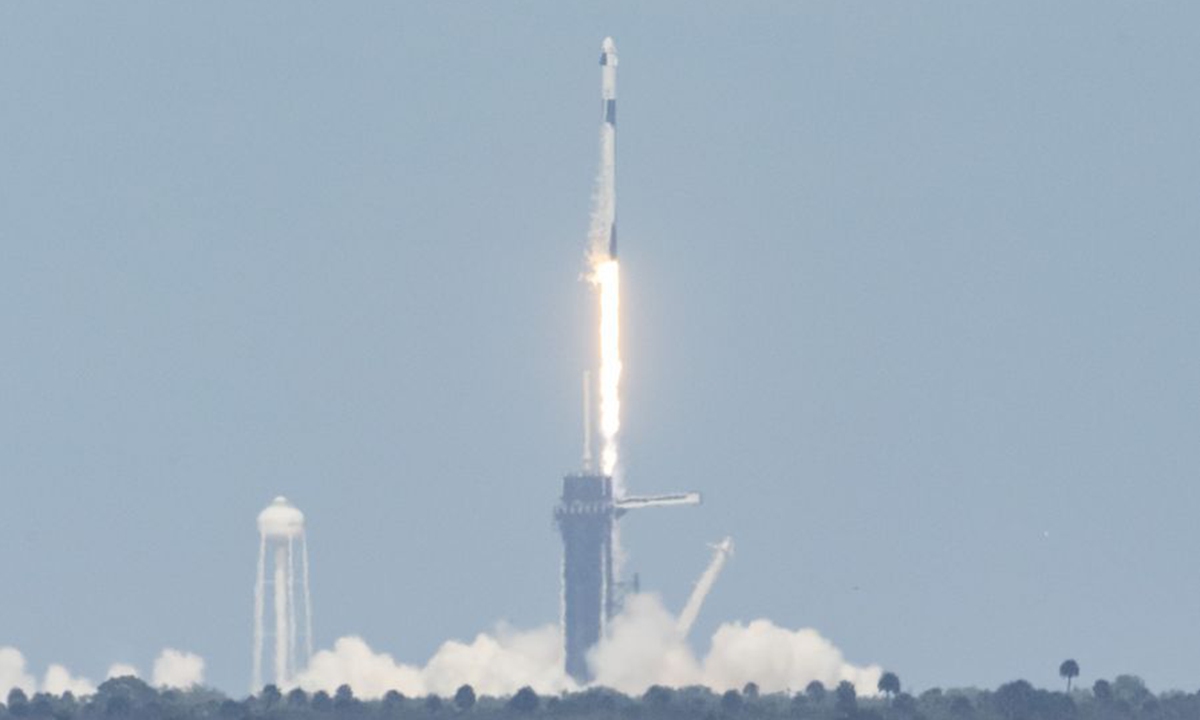Docking of SpaceX Crew Dragon at ISS above China a pure technological matter, not a political one: experts
By Deng Xiaoci Source:Global Times Published: 2020/6/2 21:57:03

SpaceX Falcon 9 rocket carrying the Crew Dragon spacecraft with two astronauts takes off from NASA's Kennedy Space Center in Cape Canaveral of Florida, the United States, on May 30, 2020. (Photo by Ting Shen/Xinhua)
SpaceX Crew Dragon's successful docking at the International Space Station (ISS) on Monday right above northern China is the result of a combination of technological issues in the mission rather than a political show-off move, space experts told the Global Times on Tuesday.
The Crew Dragon arrived at the ISS Harmony port, docking at 10:16 am EDT while the spacecraft was about 262 miles above the northern border of China and Mongolia, according to the NASA website.
Following soft capture, 12 hooks were closed to complete a hard capture at 10:27 am EDT.
Chinese netizens who had been closely following the US space mission since its launch from Florida on Monday morning, were wondering if such a docking site selection, right above the border of China and Mongolia was a muscle flexing tactic by the US space agency.
Commenting on ideas such as a "US showboat theory," Chinese space experts reached by the Global Times denied this, saying that the docking point would have been based on technological issues rather a political agenda.
There is no solid evidence to back up such speculation, a space orbit measurement expert who requested anonymity told the Global Times on Tuesday, adding that he does not believe it was designed to be aimed at China.
It was the launch window, orbiting design and docking strategy that would have determined the docking window with the ISS, and it happened to take place above the China-Mongolia border, he noted.
The top factors SpaceX would have taken into consideration for the docking mission would be trying to minimize the flight time of the spaceship as well as energy consumption in the process, another space expert with a Chinese private rocket technology start-up in Beijing, told the Global Times on Tuesday.
The position of the sun is also crucial as it affects the working temperature of the spacecraft and the performance of its optical devices, the Beijing expert explained. "The docking of the Crew Dragon happened to have a good sunshine condition up there."
Some also floated the idea that docking above China was a friendly sign, or an invitation to China's space agency or private companies for further cooperation in the space sector.
"That is very unlikely," said Song Zhongping, a military expert and TV commentator.
Song told the Global Times on Tuesday that "space cooperation between China and the US is strictly limited by various US laws."
Even the SpaceX mission was contracted by the NASA, so there is little possibility of space cooperation in the near future between China and the US, and not even between Chinese private firms and SpaceX, according to the experts.
Since the launch of the SpaceX mission, China has also completed successful launches at the Jiuquan Satellite Launch Center in Northwest China's Gansu Province and at the Xichang Satellite Launch Center in Southwest China's Sichuan Province, sending four satellites into their planned orbit.
Posted in: SOCIETY